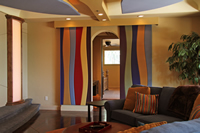Thoughtful planning will help homeowners get the most from this popular amenity.
 Home theaters were all the rage ten years ago. These rooms were designed for passively watching TV and movies, and were acoustically separated from the rest of the house. While some homeowners still want home theaters, most now opt for a media room that doubles as a game room. Getting the most from these spaces requires careful planning.
Home theaters were all the rage ten years ago. These rooms were designed for passively watching TV and movies, and were acoustically separated from the rest of the house. While some homeowners still want home theaters, most now opt for a media room that doubles as a game room. Getting the most from these spaces requires careful planning.
Media/game rooms are popular because people are spending more leisure time playing games— from multi-player virtual reality games to the weekly Texas Holdem night. A multi-purpose room that serves all these activities will enhance homeowners’ family time and increase the home’s resale value.
 The new game room might include multiple, flat-panel plasma or LCD displays for watching television, surfing the internet, and playing video games. There may also be surround-sound audio, multi-port outlets, and docks. Throw in a card table or pool table and you have a place to keep everyone happy.
The new game room might include multiple, flat-panel plasma or LCD displays for watching television, surfing the internet, and playing video games. There may also be surround-sound audio, multi-port outlets, and docks. Throw in a card table or pool table and you have a place to keep everyone happy.
Homeowners working with their builder on a media/game room need to think through how it can best serve their lifestyles. Things to consider include:
Where to put it. Location is the most important question, and the answer depends on how TV watching and game playing blends with the family’s other activities. Some homeowners want the floor plan to naturally flow from the kitchen or living area to the media/game room, which lets parents keep an eye on kids and makes it easy for guests to get drinks and snacks during the annual Super Bowl party. Such rooms typically have sliding doors so they can be isolated when needed. Other homeowners want the room in a space that’s completely separate from the rest of the house, such as the basement.
 Controlling noise. The room can be acoustically isolated with products that dampen sound transmission through the walls, floors, and ceilings. Cost-effective solutions include framing techniques that separate one side of the wall from the other (so it doesn’t vibrate like a speaker) to special membranes, insulation, acoustic tiles, and sound-deadening drywall products.
Controlling noise. The room can be acoustically isolated with products that dampen sound transmission through the walls, floors, and ceilings. Cost-effective solutions include framing techniques that separate one side of the wall from the other (so it doesn’t vibrate like a speaker) to special membranes, insulation, acoustic tiles, and sound-deadening drywall products.
Managing daylight. Natural light is great for that Saturday afternoon card game, but when it’s movie time, most people want darkness. Options include motorized screens and draperies that smoothly draw across the windows and are controlled by remote devices or wall-mounted panels. For tighter budgets, consider hand-operated blackout shades.
Accommodating technology. Though most homebuyers purchase their own consumer electronics, the media/game room needs a floor plan and a wiring infrastructure to accommodate these devices and their data feeds. People who love movies may want a 6 to 10 foot wide screen and a 7.1 surround sound system. Others may want several video displays fed by multiple signals—satellite, cable, wireless internet. Regardless of design, essential touches include flexible task lighting (tracks are good for this) as well as more electrical outlets than the homeowners think they will need.
Seating, storage, and snacks. In many media/game rooms, it’s not unusual for family members and their friends to be engaged in multiple simultaneous activities. Consider including different seating zones, as well as built-in cabinet storage for Xboxes, Wiis, and other tech gadgetry. Small kitchen setups, complete with sink, microwave, mini-fridge, and counter workspace provide additional convenience in this self-contained haven.
Although these aren’t the only questions that need to be answered when planning a media/game room, they show the complexity involved in designing a successful one. A close working relationship with a professional homebuilder is the best way to ensure that the final space works for everyone.
Copyright 2014. All rights reserved.